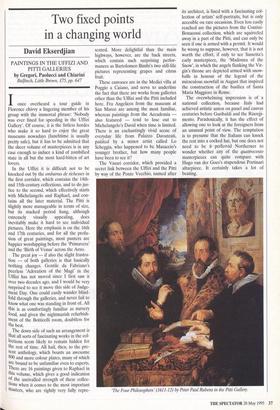Two fixed points in a changing world
David Ekserdjian
PAINTINGS IN THE UFFIZI AND PIM GALLERIES by Gregori, Paolucci and Chiarini Bulfinch, Little Brown, £75, pp. 647 Ionce overheard a tour guide in Florence chivvy a lingering member of his group with the immortal phrase: 'Nobody was ever fined for speeding in the Uffizi Gallery'. Of course, it is the listless hordes who make it so hard to enjoy the great museums nowadays (lunchtime is usually pretty safe), but it has to be admitted that the sheer volume of masterpieces is in any case enough to induce a kind of zombified state in all but the most hard-bitten of art lovers.
In the Uffizi it is difficult not to be knocked out by the embarras de richesses in the first corridor, which contains the 14th- and 15th-century collections, and to do jus- tice to the second, which effectively starts with Michelangelo and Raphael, and con- tains all the later material. The Pitti is slightly more manageable in terms of size, but its stacked period hang, although extremely visually appealing, does inevitably make it hard to see individual pictures. Here the emphasis is on the 16th and 17th centuries, and for all the profu- sion of great paintings, most punters are happier worshipping before the 'Primavera' and the 'Birth of Venus' across the Arno.
The great joy — if also the slight frustra- tion — of both galleries is that basically nothing changes. Gentile da Fabriano's Peerless 'Adoration of the Magi' in the Uffizi has not moved since I first saw it over two decades ago, and I would be very surprised to see it move this side of Judge- ment Day. One could easily wander blind- fold through the galleries, and never fail to know what one was standing in front of. All this is as comfortingly familiar as nursery food, and given the nightmarish refurbish- ment of the Botticelli room, doubtless for the best.
The down side of such an arrangement is that all sorts of fascinating works in the col- lections seem likely to remain hidden for the rest of time. All hail, then, to the pre- sent anthology, which boasts an awesome 800 and more colour plates, many of which are bound to be unfamiliar even to experts. There are 16 paintings given to Raphael in this volume, which gives a good indication of the unrivalled strength of these collec- tions when it comes to the most important Masters, who are rightly very fully repre- sented. More delightful than the main highways, however, are the back streets, which contain such surprising perfor- mances as Bartolomeo Bimbi's two still-life pictures representing grapes and citrus fruit.
These canvases are in the Medici villa at Poggio a Caiano, and serve to underline the fact that there are works from galleries other than the Uffizi and the Pitti included here. Fra Angelicos from the museum at San Marco are among the most familiar, whereas paintings from the Accademia also featured — tend to lose out to Michelangelo's David when time is limited. There is an enchantingly vivid scene of everyday life from Palazzo Davanzati, painted by a minor artist called Lo Scheggia, who happened to be Masaccio's younger brother, but how many people have been to see it?
The Vasari corridor, which provided a secret link between the Uffizi and the Pitti by way of the Ponte Vecchio, named after its architect, is lined with a fascinating col- lection of artists' self-portraits, but is only accesible on rare occasions. Even less easily reached are the pictures from the Contini- Bonacossi collection, which are squirreled away in a part of the Pitti, and can only be seen if one is armed with a permit. It would be wrong to suppose, however, that it is not worth the effort, if only to see Sassetta's early masterpiece, the 'Madonna of the Snow', in which the angels flanking the Vir- gin's throne are depicted armed with snow- balls in honour of the legend of the miraculous snowfall in August that inspired the construction of the basilica of Santa Maria Maggiore in Rome.
The overwhelming impression is of " a national collection, because Italy had achieved artistic union on panel and canvas centuries before Garibaldi and the Risorgi- mento. Paradoxically, it has the effect of allowing one to look at the foreigners from an unusual point of view. The temptation is to presume that the Italians can knock the rest into a cocked hat, but one does not need to be al peifervid Northerner to wonder whether any of the quattrocento masterpieces can quite compare with Hugo van der Goes's stupendous Portinari altarpiece. It certainly takes a lot of beating.
The Four Philosophers' (1611-12) by Peter Paul Rubens in the Pitti


































































 Previous page
Previous page